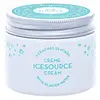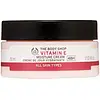What's inside
What's inside
 Key Ingredients
Key Ingredients

 Benefits
Benefits

 Concerns
Concerns

 Ingredients Side-by-side
Ingredients Side-by-side

Water
Skin ConditioningOctyldodecyl Myristate
EmollientC15-19 Alkane
SolventGlycerin
HumectantSqualane
EmollientCetyl Alcohol
EmollientGlyceryl Stearate
EmollientCaprylic/Capric Triglyceride
MaskingCetearyl Alcohol
EmollientPentylene Glycol
Skin ConditioningPEG-75 Stearate
Ceteth-20
CleansingSteareth-20
CleansingEthylhexylglycerin
Skin ConditioningButylene Glycol
HumectantSorbitol
HumectantAcrylates/C10-30 Alkyl Acrylate Crosspolymer
Emulsion StabilisingLecithin
EmollientParfum
MaskingSodium Hyaluronate
HumectantTocopheryl Acetate
AntioxidantO-Cymen-5-Ol
AntimicrobialSodium Acrylate/Sodium Acryloyldimethyl Taurate Copolymer
Emulsion StabilisingCaprylyl Glycol
EmollientPlankton Extract
Skin ConditioningSodium Hydroxide
BufferingXanthan Gum
EmulsifyingPolyglyceryl-6 Laurate
EmulsifyingLimonene
PerfumingBenzyl Salicylate
PerfumingLinalool
PerfumingTetrasodium Glutamate Diacetate
Polyglycerin-6
HumectantSodium Benzoate
MaskingSorbitan Oleate
EmulsifyingSorbitan Isostearate
EmulsifyingPotassium Sorbate
PreservativeCitronellol
PerfumingCitric Acid
BufferingWater, Octyldodecyl Myristate, C15-19 Alkane, Glycerin, Squalane, Cetyl Alcohol, Glyceryl Stearate, Caprylic/Capric Triglyceride, Cetearyl Alcohol, Pentylene Glycol, PEG-75 Stearate, Ceteth-20, Steareth-20, Ethylhexylglycerin, Butylene Glycol, Sorbitol, Acrylates/C10-30 Alkyl Acrylate Crosspolymer, Lecithin, Parfum, Sodium Hyaluronate, Tocopheryl Acetate, O-Cymen-5-Ol, Sodium Acrylate/Sodium Acryloyldimethyl Taurate Copolymer, Caprylyl Glycol, Plankton Extract, Sodium Hydroxide, Xanthan Gum, Polyglyceryl-6 Laurate, Limonene, Benzyl Salicylate, Linalool, Tetrasodium Glutamate Diacetate, Polyglycerin-6, Sodium Benzoate, Sorbitan Oleate, Sorbitan Isostearate, Potassium Sorbate, Citronellol, Citric Acid
Water
Skin ConditioningIsopropyl Palmitate
EmollientGlycerin
HumectantButylene Glycol
HumectantCetyl Alcohol
EmollientGlyceryl Stearate
EmollientPEG-100 Stearate
Cetyl Esters
EmollientMyristyl Myristate
EmollientPhenoxyethanol
PreservativeCaprylyl Glycol
EmollientTocopheryl Acetate
AntioxidantCarbomer
Emulsion StabilisingRubus Idaeus Seed Oil
EmollientParfum
MaskingSodium Stearoyl Glutamate
CleansingTrisodium Ethylenediamine Disuccinate
Sodium Hydroxide
BufferingSodium Hyaluronate
HumectantBenzyl Benzoate
AntimicrobialBenzyl Alcohol
PerfumingGeraniol
PerfumingLinalool
PerfumingLimonene
PerfumingHydroxycitronellal
PerfumingAlpha-Isomethyl Ionone
PerfumingCI 14700
Cosmetic ColorantCI 19140
Cosmetic ColorantWater, Isopropyl Palmitate, Glycerin, Butylene Glycol, Cetyl Alcohol, Glyceryl Stearate, PEG-100 Stearate, Cetyl Esters, Myristyl Myristate, Phenoxyethanol, Caprylyl Glycol, Tocopheryl Acetate, Carbomer, Rubus Idaeus Seed Oil, Parfum, Sodium Stearoyl Glutamate, Trisodium Ethylenediamine Disuccinate, Sodium Hydroxide, Sodium Hyaluronate, Benzyl Benzoate, Benzyl Alcohol, Geraniol, Linalool, Limonene, Hydroxycitronellal, Alpha-Isomethyl Ionone, CI 14700, CI 19140
 Reviews
Reviews

Ingredients Explained
These ingredients are found in both products.
Ingredients higher up in an ingredient list are typically present in a larger amount.
Butylene Glycol (or BG) is used within cosmetic products for a few different reasons:
Overall, Butylene Glycol is a safe and well-rounded ingredient that works well with other ingredients.
Though this ingredient works well with most skin types, some people with sensitive skin may experience a reaction such as allergic rashes, closed comedones, or itchiness.
Learn more about Butylene GlycolCaprylyl Glycol is a humectant and emollient, meaning it attracts and preserves moisture.
It is a common ingredient in many products, especially those designed to hydrate skin. The primary benefits are retaining moisture, skin softening, and promoting a healthy skin barrier.
Though Caprylyl Glycol is an alcohol derived from fatty acids, it is not the kind that can dry out skin.
This ingredient is also used as a preservative to extend the life of products. It has slight antimicrobial properties.
Learn more about Caprylyl GlycolCetyl Alcohol is a fatty alcohol. Fatty Alcohols are most often used as an emollient or to thicken a product.
Its main roles are:
Though it has "alcohol" in the name, it is not related to denatured alcohol or ethyl alcohol.
The FDA allows products labeled "alcohol-free" to have fatty alcohols.
Learn more about Cetyl AlcoholGlycerin is already naturally found in your skin. It helps moisturize and protect your skin.
A study from 2016 found glycerin to be more effective as a humectant than AHAs and hyaluronic acid.
As a humectant, it helps the skin stay hydrated by pulling moisture to your skin. The low molecular weight of glycerin allows it to pull moisture into the deeper layers of your skin.
Hydrated skin improves your skin barrier; Your skin barrier helps protect against irritants and bacteria.
Glycerin has also been found to have antimicrobial and antiviral properties. Due to these properties, glycerin is often used in wound and burn treatments.
In cosmetics, glycerin is usually derived from plants such as soybean or palm. However, it can also be sourced from animals, such as tallow or animal fat.
This ingredient is organic, colorless, odorless, and non-toxic.
Glycerin is the name for this ingredient in American English. British English uses Glycerol/Glycerine.
Learn more about GlycerinGlyceryl Stearate is a mix of glycerin and stearic acid.
It is used to stabilize the mixing of water and oil ingredients. By preventing these ingredients from separating, it can help elongate shelf life. It can also help thicken the product's texture.
As an emollient, it helps soften skin and supports barrier-replenishing ingredients.
In cosmetics, Glyceryl Stearate is often made from vegetable oils or synthetically produced.
This ingredient may not be fungal-acne safe
Fun fact: The human body also creates Glyceryl Stearate naturally.
Learn more about Glyceryl StearateLimonene is a fragrance that adds scent and taste to a formulation.
It's found in the peel oil of citrus fruits and other plants such as lavender and eucalyptus. The scent of limonene is generally described as "sweet citrus".
Limonene acts as an antioxidant, meaning it helps neutralize free radicals.
When exposed to air, oxidized limonene may sensitize the skin. Because of this, limonene is often avoided by people with sensitive skin.
The term 'fragrance' is not regulated in many countries. In many cases, it is up to the brand to define this term. For instance, many brands choose to label themselves as "fragrance-free" because they are not using synthetic fragrances. However, their products may still contain ingredients such as essential oils that are considered a fragrance.
Learn more about LimoneneLinalool is a fragrance and helps add scent to products. It's derived from common plants such as cinnamon, mint, citrus, and lavender.
Like Limonene, this ingredient oxidizes when exposed to air. Oxidized linalool can cause allergies and skin sensitivity.
This ingredient has a scent that is floral, spicy tropical, and citrus-like.
Learn more about LinaloolParfum is a catch-all term for an ingredient or more that is used to give a scent to products.
Also called "fragrance", this ingredient can be a blend of hundreds of chemicals or plant oils. This means every product with "fragrance" or "parfum" in the ingredients list is a different mixture.
For instance, Habanolide is a proprietary trade name for a specific aroma chemical. When used as a fragrance ingredient in cosmetics, most aroma chemicals fall under the broad labeling category of “FRAGRANCE” or “PARFUM” according to EU and US regulations.
The term 'parfum' or 'fragrance' is not regulated in many countries. In many cases, it is up to the brand to define this term.
For instance, many brands choose to label themselves as "fragrance-free" because they are not using synthetic fragrances. However, their products may still contain ingredients such as essential oils that are considered a fragrance by INCI standards.
One example is Calendula flower extract. Calendula is an essential oil that still imparts a scent or 'fragrance'.
Depending on the blend, the ingredients in the mixture can cause allergies and sensitivities on the skin. Some ingredients that are known EU allergens include linalool and citronellol.
Parfum can also be used to mask or cover an unpleasant scent.
The bottom line is: not all fragrances/parfum/ingredients are created equally. If you are worried about fragrances, we recommend taking a closer look at an ingredient. And of course, we always recommend speaking with a professional.
Learn more about ParfumSodium Hyaluronate is hyaluronic acid's salt form. It is commonly derived from the sodium salt of hyaluronic acid.
Like hyaluronic acid, it is great at holding water and acts as a humectant. This makes it a great skin hydrating ingredient.
Sodium Hyaluronate is naturally occurring in our bodies and is mostly found in eye fluid and joints.
These are some other common types of Hyaluronic Acid:
Learn more about Sodium HyaluronateSodium Hydroxide is also known as lye or caustic soda. It is used to adjust the pH of products; many ingredients require a specific pH to be effective.
In small amounts, sodium hydroxide is considered safe to use. However, large amounts may cause chemical burns due to its high alkaline.
Your skin has a natural pH and acid mantle. This acid mantle helps prevent harmful bacteria from breaking through. The acid mantle also helps keep your skin hydrated.
"Alkaline" refers to a high pH level. A low pH level would be considered acidic.
Learn more about Sodium HydroxideTocopheryl Acetate is AKA Vitamin E. It is an antioxidant and protects your skin from free radicals. Free radicals damage the skin by breaking down collagen.
One study found using Tocopheryl Acetate with Vitamin C decreased the number of sunburned cells.
Tocopheryl Acetate is commonly found in both skincare and dietary supplements.
Learn more about Tocopheryl AcetateWater. It's the most common cosmetic ingredient of all. You'll usually see it at the top of ingredient lists, meaning that it makes up the largest part of the product.
So why is it so popular? Water most often acts as a solvent - this means that it helps dissolve other ingredients into the formulation.
You'll also recognize water as that liquid we all need to stay alive. If you see this, drink a glass of water. Stay hydrated!
Learn more about Water